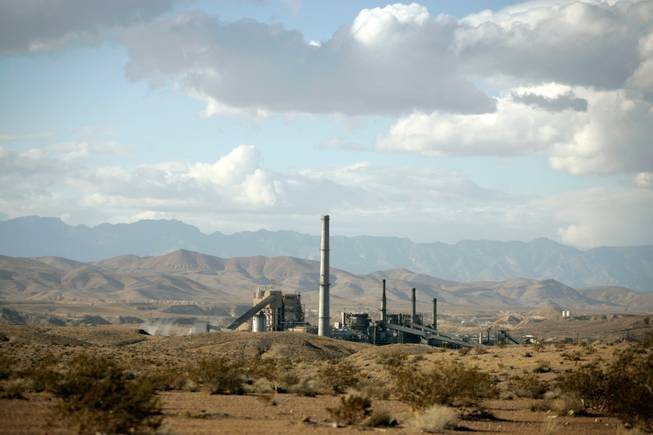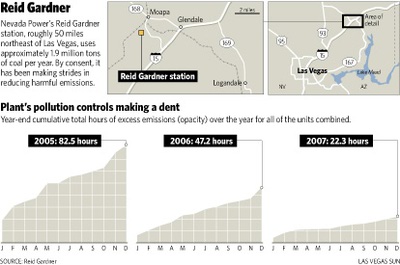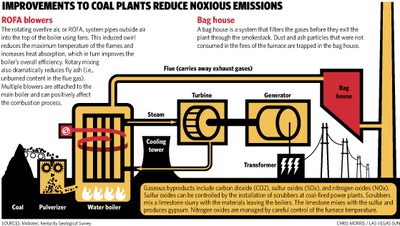
A settlement between Nevada Power Co. and government regulators sparked spending of $85 million at Reid Gardner, 50 miles northeast of Las Vegas. The company hopes to pass its cleanup costs on to consumers.
Sunday, Feb. 10, 2008 | 2 a.m.
A 50-mile drive northeast from Las Vegas on Interstate 15 leads through scrub desert to the pastoral Moapa Valley, where farmers farm and cows graze under a fresh, wind-scrubbed sky.
In the distance are the four smokestacks of the infamous Reid Gardner power plant, which has earned the scorn of environmentalists as one of the nation’s dirtiest coal-fired generators. But today the plant, which for 43 years has provided electricity to feed Nevada’s growth, no longer belches as much soot and smoke. Reid Gardner is in the midst of an $85 million overhaul to clean up its emissions.
The improvements stem from a settlement announced in April between Nevada Power Co. and state and federal environmental protection agencies. The settlement came after a yearlong investigation by the state into 56 alleged violations of pollution limits and record-keeping regulations. Without the improvements, Reid Gardner would have been forced to shut down.
With the company expecting to wrap up installation of new technology in 2009, the Sun decided to take a look at its progress.
One result is immediately obvious: clearer skies. Nevada Power has cut the amount of visible soot and smoke from its Reid Gardner stacks by half in each of the past two years, with more to come.
Environmentalists, usually quick to criticize the power company, applaud the improvements.
John Thompson of the Clean Air Task Force, a nonprofit environmental group, said the federal Environmental Protection Agency estimates that every dollar spent nationally on pollution control improvements saves $10, mostly in health care costs. That figure might be lower in the West, where populations are more dispersed, but the benefits still outweigh the cost, Thompson said.
The improvements include retrofitting the plant’s three oldest units — built in 1965, 1968 and 1976 — with giant air filters that remove dust and ash particles from smokestack emissions. A fourth unit, built in 1983, already has one of the filters.
The company also is changing the way it lights the giant boilers that burn pulverized coal dust at the plant. Igniters used to heat the boilers and make them burn coal more efficiently are being changed from diesel fuel to natural gas.
The use of diesel fuel causes puffs of black smoke, which violate environmental regulations. Natural gas burns more cleanly. Most of the cost of conversion is to build an extension to the Kern natural gas pipeline.
Another major improvement, being made to the fourth unit, is to pump air into the top of the boiler to reduce production of nitrogen oxide emission by 30 to 40 percent. The pollutant contributes to formation of ozone.
Dante Pistone, a spokesman with the state’s Environmental Protection Division, said the agency also is requiring the utility to clean up and monitor ponds used to store waste from scrubbers and cooling towers. That should address long-standing complaints from the Moapa band of Paiutes, whose reservation abuts the plant site, about a sulfur stench from those ponds.
Pistone said the division hasn’t received complaints about the smell in several months. “That’s usually a pretty good gauge that something’s working,” he said.
Work on the ponds is not part of the settlement.
Mike Elges, chief of the Air Pollution Control Bureau for the state Environmental Protection Division, said historical environmental issues with Sierra Pacific Resources, Nevada Power Co.’s parent, have faded since the settlement.
“There has been a 180-degree change in the management ... of environmental issues,” Elges said. “They’ve really made some incredible changes that have resulted in dramatic changes at the facility from an air quality and, in general, an environmental perspective.”
The company plans to pass the costs of the improvements on to consumers, pending approval by the Nevada Public Utilities Commission. Those costs amount to pennies a day for average consumers, said Mark Severts, a spokesman for Sierra Pacific Resources.
Consumers would have had to pay much more if the plant had been forced to shut down, forcing the company to buy power on the wholesale market, Severts said.
The company says it will reuse most of the equipment once the three oldest units are shut down. That will occur if and when the company builds a new 1,500-megawatt coal-fired generating facility near Ely. Approvals for that plant are pending. It could open as early as 2013.
Severts said the Ely Energy Center project would emit about the same amount of sulfur as Reid Gardner, even though the new plant will be five times the size. Reid Gardner provides Southern Nevada with 300 megawatts of power, enough to serve 225,000 homes.
The new plant also would emit less nitrogen dioxide than the three older units at Reid Gardner, he said.
Carbon dioxide emissions, however would be much higher at Ely. The three older units at Reid Gardner use 1.9 million tons of low-sulfur Utah coal each year and emit 2.8 million tons of carbon dioxide, the greenhouse gas that causes global warming. The Ely plant would emit about 10 million tons of carbon dioxide.



Join the Discussion:
Check this out for a full explanation of our conversion to the LiveFyre commenting system and instructions on how to sign up for an account.
Full comments policy